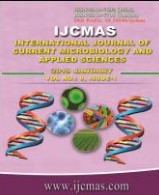


 National Academy of Agricultural Sciences (NAAS)
National Academy of Agricultural Sciences (NAAS)

|
PRINT ISSN : 2319-7692
Online ISSN : 2319-7706 Issues : 12 per year Publisher : Excellent Publishers Email : editorijcmas@gmail.com / submit@ijcmas.com Editor-in-chief: Dr.M.Prakash Index Copernicus ICV 2018: 95.39 NAAS RATING 2020: 5.38 |
Castor is a non-edible oilseed crop, primarily grown for oil containing an unusual hydroxy fatty acid and ricinoleic acid (80–90%) of the total fatty acids. Commercial exploitation of heterosis in castor was successful in India due to the development of stable pistillate lines from a dominant and epistatic “S” type pistillate source. Diversification of pistillate sources using NES and other new sources necessitated the need for identification of diverse male combiners among the existing pool of male combiners. In this study, 60 breeding lines/genotypes were characterized for genetic diversity and population structure using EST-SSRs primers. SSR allelic variation was low as indicated by the average number of alleles (2.8), gene diversity (0.53) and polymorphic information content (0.45). Cluster analysis (neighbor joining tree) revealed 3 major genotypic groups. The genotypes showed weak population structure (membership coefficients (≥ 0.75)) and 66.7% genotypes were classified into 3 populations (K=3) and the remaining 33.3% genotypes into admixture group in STRUCTURE analysis. The genetic diversity information generated in this study would assist in selection of diverse genotypes for breeding to exploit heterosis for development of hybrids.
 |
 |
 |
 |
 |